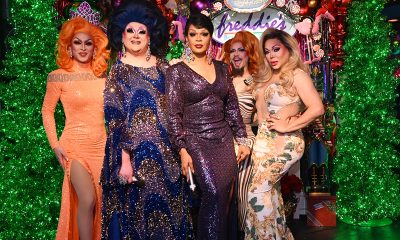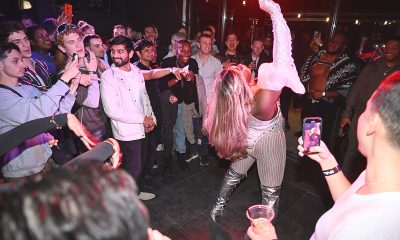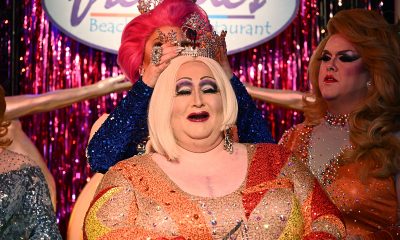Living
Other mothers
Local performers honor their drag moms
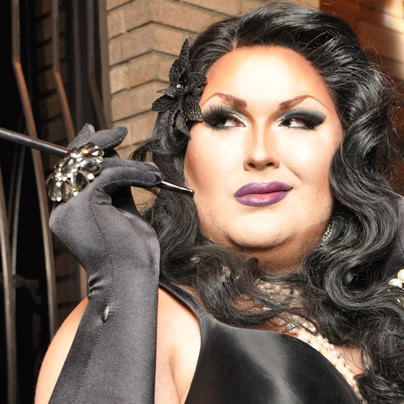
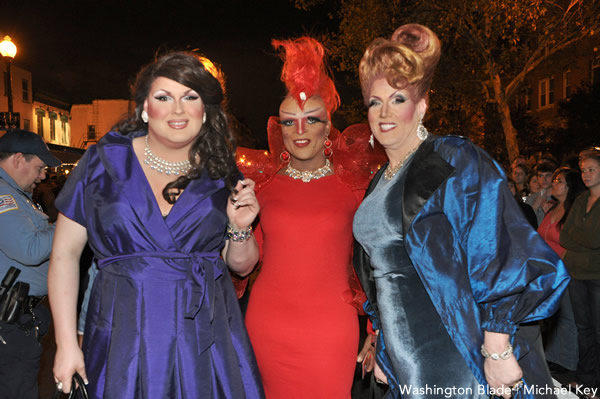
Ba’Naka, Shi-Queeta-Lee and Lena Lett (Washington Blade photo by Michael Key)
Spend any real time in the gay world and you know there are many who take drag very seriously, from the elaborate routines to the familial ties.
Since this weekend is Mother’s Day, we asked a few local performers why drag families are important. It didn’t take long to realize it’s about a lot more than borrowing lipstick or getting input on a new gown.
“It truly is family,” says Muffy Blake-Stephyns. “Few people know me quite as well as my drag family. We complete each other’s sentences, we know just what to say or do to comfort one another. We have each other’s back.”
“We’re closer than your actual blood relatives,” says Alexandra B. Childs. “We sew, rhinestone, glue, paint, staple, smile and lip sync our hearts out for one another. Our drag family hangs out together in and out of the drag scene. Drag events are like a weekly family reunion for us with a lot more hairspray and sequins involved than most others.”
“Drag families are just an elaborate support system,” Ba’Naka says. “A sisterhood that is there for you when you need it.”
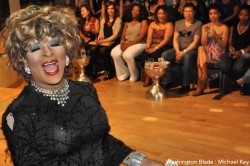
Shi-Queeta-Lee (Washington Blade photo by Michael Key)
Drag name: Shi-Queeta-Lee
Boy name: Jerry VanHook
Drag mother’s name: Chyna Pendar’vis/Benjamin Smith
How did you meet? I met Chyna Pendar’vis (RIP) through a friend of mine, Don Pendar’vis (RIP). I was competing for the Miss Magic Pageant 1998, which I won singing live Whitney Houston “Your Love Is My Love.” The pageant is part of the Gay Softball league here in D.C. called Chesapeake and Potomac Softball League (CAPS). I painted myself for it and Don came over to help me and he said, “Girl you look a hot ghetto mess.” So he calls Chyna to come and do my makeup and clothes. I was always told the first drag queen that paints you and put you in drag is your drag mother. She taught me the ropes on drag life and the drama that comes with it.
What does she mean to you? She means the world to me. Taught me so much on life in the gay community. How to get booked for drag shows, how to host to get patrons excited to see drag queens perform. She was a pageant girl, so she guided me on how to compete as well. Chyna was a diva at her craft, also had a loving family that supported the art form. I had a loving family that supported me.
Drag name: Kuji Lee
Boy name: Kuji Mah Ajani
Drag mother’s name: Shi-Queeta-Lee aka Jerry VanHook
How did you meet? I met my drag mom at a nightclub called “The Edge” that used to be located in Southeast Washington near the Navy Yard Marine Base. Shi-Queeta-Lee wasn’t born yet (I don’t believe), so the first three years of our interaction was with Jerry. Later I ran into her again and she introduced me as her child, which I didn’t dispute. It was then that I began to carry the last name “Lee.” A few years later, the birth of Shi-Queeta-Lee arrived in D.C. and started hosting a drag show at the famous Bachelor’s Mill. I was infatuated with drag performances for many years that I began to secretly desire to hit the stage as a male entertainer one day and Shi-Queeta-Lee was the first to give me my start.
What does she mean to you? Shi-Queeta-Lee is and will always be the catalyst of our family. She is also a well-known public figure who has endured ridicule, harsh criticism, etc. within our gay community for believing that the drag-gay/bi/transgender community can reach higher ground if presented in a different framework that connects all genders, all races. She embodies diversities, complexity, independence, boldness, unconditional love, vulnerability, creativity and more. She never let anyone or anything halt her goals or dreams and she makes sure we as her family apply those same beliefs.
Drag name: Shelby Blake-Stephyns
Boy name: Jon Rybka-Wachhaus
Drag mother’s name: Veronica Blake (Rob Amos)
How did you meet: I had been doing drag for approximately two years and had become a member of The Academy of Washington, Inc. We had become close and when my previous mother and I had a falling out, she asked me if I would be her daughter because she saw so much in me that wasn’t being nurtured and needed to be. And the rest, as they say is history.
What does your drag mother mean to you? Veronica means the world to me. Many times I get so many ideas in my head that it’s great to have someone there to help you sort it all out to make you the best you can be. She can be tough as leather sometimes but she always has my best interest at heart.
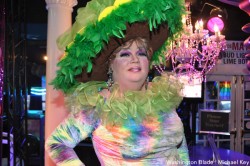
Daniel Hays A.K.A. Muffy Blake Stephyns (Washington Blade photo by Michael Key)
Drag name: Muffy Blake-Stephyns
Boy name: Daniel L. Hays
Drag mother’s name: Shelby Blake Stephyns/Jon Rybka-Wachhaus
How did you meet? I met Shelby at a benefit drag show at Freddie’s Beach Bar. I had been doing drag for a number of years, but at that particular time I was going through some health challenges and was battling depression. She was just kind of the perfect prescription. She was incredibly caring, uplifting and made me want to continue performing. Over the next few weeks we talked pretty much every day. Before long it was official, I had changed “families” and Shelby became my mom. I think I can safely say that were it not for Shelby coming into my life, in all likelihood Muffy would have hung up her heels.
What does she mean to you? My drag mother truly means the world to me. I know she loves me unconditionally and that is something that is felt in return. If I need something, I know without a doubt that if there is any way my drag mother can help she will be there, no questions asked. I am truly blessed to have Shelby Blake Stephyns as my mama.
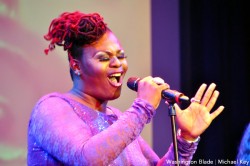
Delila B. Lee (Washington Blade photo by Michael Key)
Drag name: Delila B. Lee
Boy name: Delonte’ Ladson
Drag mother’s name: Shi-Queeta-Lee/Jerry Vanhook
How did you meet? I met Shi-Queeta-Lee in 2009 at Town Danceboutique. And I was amazed of the illusion she gave as Tina Turner. She got me into drag by teaching me how confidence is the key. And completely being myself. I was very interested in becoming a drag queen. The desire to transform into a beautiful diva and lip sync on stage. I first performed in 2011.
What does she mean to you? A drag family is being together, supporting and loving one another. It should be treasured forever. Most of us don’t have supportive families because they don’t accept and tolerate our lifestyles. Having a drag family means knowing you’ll be loved unconditionally. I’m proud to call Mother Lee my drag mother.
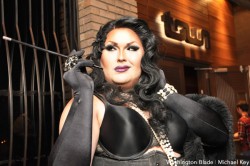
Ba’Naka (Washington Blade photo by Michael Key)
Drag name: Ba’Naka
Boy name: Dustin Michael Schaad
Drag mother’s name: When they say it takes a village they weren’t joking! I don’t have one singular drag mother. From Florida to D.C., I’ve collected a harem of Mommie Dearests but the most influential have been D.C. icons Lena Lett and Kristina Kelly (David Lett and Chris Smith).
How did you meet? I met Kristina Kelly at Apex when I first moved to D.C. She was the first queen to give me a chance in this city. I began regularly performing with her at various D.C. venues: Apex, Omega, Remington’s, Be-Bar. She taught me how to paint a face and take the stage. As for Lena, she has never been my official drag mother but I’ve learned more from her than any other. From her I learned how to host a show and command an audience (hosting is 10 times harder than performing). Lena over the years has given me some of the best advice (not that I always listen — I’m hard headed) that I have ever received.
What does she mean to you? My drag mothers have been a source of wisdom, experience and comfort over the years.
Drag name: Hope B. Childs
Boy name: Steven Ramsey
Drag mother’s name: Destiny B. Childs/Richard Legg
How did you meet? I met my drag mother years ago when I tried to commit suicide. She and her husband picked me up and let me live with them. She helped me become the true me. I started in the drag scene as her dresser and anywhere she went, I went. Rhinestoning her shoes and outfits and putting her outfits together. I first started doing drag without her really knowing (not a good idea to doing something behind your mother’s back). She helps me with whatever I need.
What does she mean to you? She is my best friend she means the world to me. She’s not my drag mom she is my mom.
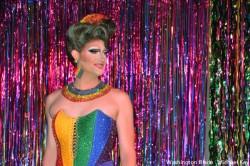
Alexandra B. Childs (Washington Blade photo by Michael Key)
Drag name: Alexandra B. Childs (Miss Capital Pride 2012)
Boy name: Chad Phillips
Drag mother’s name: Destiny B. Childs/Richard Legg
How did you meet? I met Destiny at Freddie’s Beach Bar in Crystal City, shortly after I moved to D.C. and came out. Theater was always something that I enjoyed and drag to me is an extension of that. I had toyed with the idea of trying drag and voiced it several times to some people. The first time I was put into drag was by Destiny’s drag mother, Ophelia Bottoms. After that it was something that I knew that I loved and the creativity is endless. Destiny took me in and gave me advice and sources for items and ideas to advance in the craft. And here I am, Miss Capital Pride 2012 about to step down and I owe it all to my mother and the family that we call the Childs clan!
What does she mean to you? Destiny/ Ric is more than a drag mother. We have a friendship that is more than just lashes and lipstick. Destiny is that person who knows my look from across the room, the one who is honest enough to say “Girl, not that hair,” the one who magically has the Mary Poppins “bag of stuff” if we forget something or need something. She is a person who in or out of drag consistently gives back to the community and those around her.
Advice
How to cope when a partner gives you the silent treatment
Punishing behavior brings up memories of parent’s mistreatment
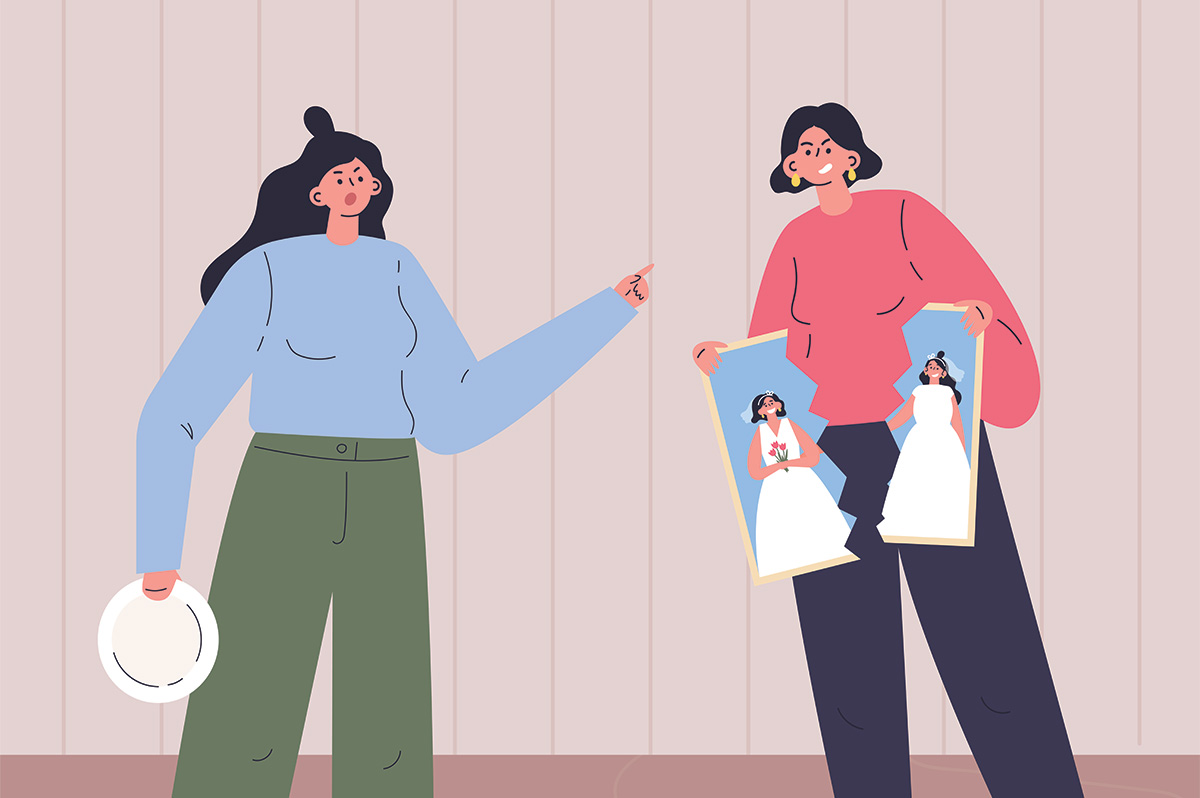
Michael,
My wife and I met less than two years ago and we were crazy about each other from the start. We wanted to spend life together so we just went for it. Maybe this wasn’t the most well-thought out decision on either of our parts but we thought that love conquers all.
But lately we’ve been arguing. The stuff we’re fighting about is never such a big deal: chores, or spending, or wanting to do different things on the weekend. But when I don’t want to go along with Michelle’s point of view, she gets angry and shuts down. Sometimes she stops talking to me for as long as a few days.
This is painful for me. My mom used to pull this stunt when I was a kid and she was mad at me. She also cut me off when I came out. We’re still estranged.
Michelle has a whole different take on this. She says I am being “mean” to her (when I don’t go along with what she wants) and this is painful, and she has to “take a break” to cool off.
I know she comes from a volatile family. She has told me there was a lot of screaming in her house, and she barely has a relationship with her parents as a result. So I get that she’s sensitive to conflict.
But I don’t think I’m being mean to her by standing up for what I want — certainly not enough to warrant her giving me the silent treatment.
We got married to have a great life together. We often do but I can’t live with someone who just shuts me out when she’s annoyed with me.
If I became a doormat and went along with everything she wants and never pushed back or complained, maybe she wouldn’t shut down. But I don’t want to do that.
I’d appreciate some ideas to improve the situation. I don’t want a divorce but I also don’t want to keep being mistreated.
Michael replies:
You can think of marriage — or any serious relationship — as a gym where you have ongoing opportunities to become an increasingly resilient person in the face of the ongoing challenges that an intimate relationship poses.
Your task here is to shift your focus toward figuring out how to handle yourself well, even in the awful circumstance of getting the silent treatment.
Michelle is not under an obligation to behave as you’d like her to. You can certainly ask her to stop withdrawing when she’s angry at you. But that doesn’t mean she is going to honor your request.
I well understand that Michelle’s punishing behavior is bringing up painful memories of your mother’s mistreatment. But if she doesn’t change her behavior, you have to find a way to live with Michelle as she is, with as much equanimity as you can muster, for as long as you choose to be married to her. If she does not change and you find her behavior to be unbearable, you can leave.
Every time she shuts down, Michelle is handing you an opportunity to figure out how you, yourself, can deal with feeling hurt and let down, rather than depending on someone else to behave as you’d like her to, or not upset you, or soothe you. Being in charge of your own mood rather than letting someone else press your buttons is a great skill to get better at.
I’m not going focus on what techniques you might use to soothe yourself — that’s a different column (or even better, a number of therapy sessions). That said, knowing that Michelle’s behavior comes from her history might help you to take it less personally. And, simply keeping in mind that living with a difficult spouse is unavoidable and worth getting better at may help you to quiet yourself down.
Another challenge that your marriage is pushing you to work on: Discerning when you can be generous, and when it is important to have a boundary. Of course, I understand that you don’t want to be a doormat by going along with whatever Michelle says and wants. But is it possible that she has a point, in that you could stand to lean more in her direction?
None of us get to have everything the way we want when we are in a relationship (much less in life). Figuring out the interplay between generosity and boundary is complicated. It often involves considering what is important to your partner; and deriving joy from her getting some of what is important to her, not only from your getting what you would like. And of course, it also involves figuring out what is most important to you.
If you set a boundary thoughtfully, because something is important to you, and Michelle doesn’t like it, you’re being handed an opportunity to get better at tolerating disappointment. Being a disappointment to your partner, and being disappointed in your partner, are both unavoidable parts of marriage: We’re all different, and at times will make choices that the other person really does not like.
If we make our decisions from a place of integrity rather than whim, entitlement, anger, or “whose turn it is”, and strive to honor the choices that our partners make from a place of integrity, this often makes the disappointment easier to bear.
Of course, it would be great if Michelle would join you in working to become a more solid and resilient spouse. As I mentioned earlier, you can’t persuade her to do so. But you can certainly tell Michelle what you are working on and ask her to consider how she, too, might use your relationship difficulties as a challenge to grow.
It isn’t easy to have such a conversation without sounding condescending. You are better positioned to do so when you are walking the walk, not just talking the talk. One good rule of thumb is to put you and your partner in the same boat, making it clear that you see the two of you as facing the same challenges, rather than positioning yourself in a superior position. Another is to initiate the conversation when you are both calm, rather than in the middle of a fight or when you’re getting the silent treatment.
One more point: If Michelle is willing, I’d suggest that you propose couples therapy as an opportunity for you two to collaborate on building a consistently loving relationship where neither of you lets your reactivity run the show.
Michael Radkowsky, Psy.D. is a licensed psychologist who works with couples and individuals in D.C. He can be found online at michaelradkowsky.com. All identifying information has been changed for reasons of confidentiality. Have a question? Send it to [email protected].

Electric-vehicle tax credits may have faded earlier this year, but EVs themselves are far from losing their spark. There are more charging stations than ever, battery ranges are longer and more realistic, and automakers have finally figured out that EVs don’t all need to look like geeky science projects or feel like failed beta tests.
Just look at these two compact electrics, which are futuristic, fun and flexible enough for work or play.
HYUNDAI IONIQ 5
$37,000 to $48,000
Range: 245 to 318 miles
0 to 60 mph: 4.5 to 7.4 seconds
Cargo space: 26.3 cu. ft.
PROS: Fast charging. Roomy cabin. Silky-smooth suspension.
CONS: Wide turning radius. Rear wiper not on all trims. Price creep.
After being introduced three years ago, what’s new for the latest Hyundai Ioniq 5? Mostly refinement. Charging is quicker, software is smarter and Hyundai continues to quietly listen to feedback, tweaking ride comfort and usability. Think of it as switching from messy eyeliner to a perfectly sharp wing.
Exterior styling remains one of this EV’s biggest conversation starters. Those pixel-inspired lights, crisp lines and slick hatchback-meets-crossover proportions exude refreshing confidence. There’s no trying to blend in, and that’s the point. Park this Hyundai anywhere and heads will turn.
On the road, the Ioniq 5 prioritizes calm over chaos. Steering is light, the suspension smooths out rough pavement and acceleration feels brisk without being aggressive. Safety tech is plentiful and well-calibrated—adaptive cruise control, lane-centering, blind-spot monitoring—all working together without seeming like a nervous backseat driver. IOW, this ride is supportive, not clingy.
Inside, the user-friendly cabin shines. The flat floor and long wheelbase create a lounge-like atmosphere, with excellent legroom and airy visibility. Seats are well-bolstered and available with eco-friendly materials, and the sliding center console adds flexibility. Cargo space is generous, and the wide windshield makes city driving stress-free. Alas, the rear wiper is only available on select models. Overall, though, I appreciated how everything looks modern without feeling cold.
What makes this Hyundai special is its vibe. An EV that embraces individuality without shouting about it.
Fun fact: The Ioniq’s ultra-fast charging can add hundreds of miles in under 20 minutes—perfect for those who hate waiting almost as much as they hate small talk on awkward first dates.
VOLKSWAGEN ID.4
$46,000 to $59,130
Range: 206 to 291 miles
0 to 60 mph: 4.4 to 7.7 seconds
Cargo space: 30.3 cu. ft.
PROS: Sure handling. Decent range. Good storage.
CONS: Body roll in curves. Fussy infotainment. No frunk.
The latest VW ID.4 focuses on polish. Software updates have fixed earlier frustrations, and overall drivability feels more cohesive. Less “learning curve” and more “hop in and go,” like a dependable bestie who doesn’t overthink things.
Styling-wise, this EV is intentionally inoffensive. Soft curves, friendly lighting and a familiar crossover shape make it approachable. While the ID.4 won’t turn heads like the Ioniq 5, that’s OK. It’s more akin to a classic outfit that always works—timeless, not trendy.
Driving the ID.4 is relaxed and predictable. This SUV prioritizes comfort over thrills, with a suspension tuned for daily commuting and long highway drives. Safety features are comprehensive and reassuring, including excellent lane assistance and collision-prevention systems. It’s the kind of car that quietly has your back, no drama required.
Inside, the ID.4 offers a calm, uncluttered cabin with good space for passengers and cargo alike. Rear-seat legroom is especially strong, making it a solid road-trip companion. The seats are plush, visibility is good and while the infotainment system isn’t the most intuitive, it’s improved enough to be more than tolerable.
The ID.4’s special sauce is balance. It doesn’t try to reinvent the wheel—it just electrifies it.
Fun fact: This is one of the most globally popular EVs, proving that sometimes being universally liked is a strength, not a personality flaw. Think, gold star gay who still surprises you.

Real Estate
Child- and pet-proofing your home for the holidays
It isn’t about being perfect but about being prepared

The holidays are meant to be joyful, cozy, and full of laughter — but if you have young children or pets, they can also feel a little chaotic. Twinkling lights, shiny decorations, guests coming and going, and tables full of tempting food can turn your home into a wonderland of curiosity and mischief. The good news? With a little thoughtful planning, you can keep the holiday magic alive while making your home safer for everyone who lives there.
There’s something oddly comforting about movies where animals go to war with holiday decorations, turning carefully strung lights and perfectly placed ornaments into chaos. Whether it’s a mischievous dog tangled in tinsel or a curious cat launching a full-scale assault on a Christmas tree, these scenes tap into a universal experience for pet owners.
The humor comes from the contrast: the human characters are trying to create warmth, tradition, and picture-perfect cheer, while the animals see the decorations as toys, obstacles, or personal enemies. The resulting destruction — trees tipping over, ornaments shattering, lights blinking out—feels exaggerated but relatable, especially during the already hectic holiday season.
Let’s start with decorations because they tend to be the biggest attraction. Ornaments sparkle, garlands dangle, and everything seems designed to be touched, pulled, or tasted. If you have little ones or pets, consider placing your most fragile ornaments higher on the tree and using shatterproof options on the lower branches. Tinsel and ribbon may look festive, but they can be dangerous if swallowed, so skipping them or keeping them well out of reach is a simple way to reduce risk without sacrificing style.
Holiday lights are another favorite fascination. Before hanging them, take a few minutes to inspect each strand for frayed wires or broken bulbs. Secure cords along walls or behind furniture so they’re harder to grab or chew and unplug them when you leave the house or head to bed. Not only does this help prevent accidents, but it also gives you one less thing to worry about during a busy season.
The Christmas tree itself can become a focal point for exploration. Make sure it’s sturdy and well-anchored so it doesn’t tip if a toddler tugs on a branch or a pet decides to investigate. If you use a real tree, cover the water base since tree water can contain additives that aren’t safe if consumed. For artificial trees, keep an eye out for loose pieces or needles that could become choking hazards.
Food is a big part of holiday celebrations, and it’s also one of the most common sources of trouble. Many traditional treats—like chocolate, grapes, raisins, alcohol, and foods containing xylitol—are dangerous for pets. Keep plates and serving dishes up high, secure the trash can, and gently remind guests not to slip pets or kids “just a little bite” without checking first. For children, be mindful of hard candies, nuts, and small treats that could pose choking risks.
Candles and fireplaces add warmth and charm, but they deserve extra caution. Flameless candles are a wonderful alternative if you want ambiance without worry. If you do use real candles, place them well out of reach and never leave them unattended. Fireplaces should always have a sturdy screen or gate, especially with crawling babies or curious pets nearby.
Holiday gatherings bring wonderful energy into your home, but they can also create new challenges. Doors opening frequently make it easier for pets to slip outside, so consider setting up a quiet, comfortable space where they can relax during busy get-togethers. This can help reduce stress for them and give you peace of mind. For children, stair gates, locked cabinets, and clear boundaries can help prevent accidents when there’s extra excitement in the air.
New toys and gifts are another thing to watch closely. Packaging, twist ties, plastic wrap, and especially button batteries should be cleaned up promptly. These items are easy to overlook in the excitement of gift-opening but can be dangerous if swallowed. Taking a few minutes to tidy up as you go can make a big difference.
Lastly, try to keep routines as steady as possible. The holidays naturally disrupt schedules, but familiar mealtimes, naps, walks, and bedtime rituals help children and pets feel secure. A calmer household often means fewer accidents and a happier experience for everyone.
At the end of the day, child- and pet-proofing your home for the holidays isn’t about being perfect but about being prepared. A few small adjustments can help you relax, enjoy your guests, and focus on what truly matters: creating warm, happy memories with the ones you love. When your home feels safe, the holidays feel even sweeter.
Valerie M. Blake is a licensed Associate Broker in D.C., Maryland, and Virginia with RLAH @properties. Call or text her at 202-246-8602, email her at [email protected] or follow her on Facebook at TheRealst8ofAffairs.

